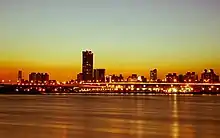Afterglow
An afterglow is a broad arch of whitish or pinkish sunlight in the sky that is scattered by fine particulates, like dust, suspended in the atmosphere. An afterglow may appear above the highest clouds in the hour of fading twilight or be reflected off high snowfields in mountain regions long after sunset. The particles produce a scattering effect upon the component parts of white light.[1] The opposite of an afterglow is a foreglow, which occurs before sunrise.

True alpenglow, which occurs long after sunset or long before sunrise, is caused by the backscattering of red sunlight by aerosols and fine dust particles low in the atmosphere. After sunset, alpenglow is an afterglow caused by the illumination of atmospheric particles by sunlight as it gets refracted and scattered through the Earth's atmosphere.
The high-energy and high-frequency light is scattered out the most, while the remaining low-energy and -frequency light reaches the observer on the horizon at twilight. The backscattering of this light further turns it pinkish to reddish. This period of time is referred to as the blue hour and is widely treasured by photographers and painters.[2]
The afterglow persists until the Earth's shadow (terminator line) overtakes the sky above the observer as night falls and the stars appear, with Venus (the second-brightest celestial object after the Moon in the night sky) visible above the horizon opposite of the Belt of Venus around the antisolar point.
After the 1883 eruption of the volcano Krakatoa, a remarkable series of red sunsets appeared worldwide. An enormous amount of exceedingly fine dust were blown to a great height by the volcano's explosion, and then globally diffused by the high atmospheric winds. Edvard Munch's painting The Scream possibly depicts an afterglow during this period.
 Sunset in Hong Kong after the 1991 eruption of Mount Pinatubo
Sunset in Hong Kong after the 1991 eruption of Mount Pinatubo
 An afterglow in Slovenian mountains, near Triglav Lakes Valley
An afterglow in Slovenian mountains, near Triglav Lakes Valley
 An afterglow at a pier in Australia
An afterglow at a pier in Australia An afterglow on Kraków's housing estate
An afterglow on Kraków's housing estate
References
- "Afterglow". Word Across. Retrieved 2019-12-10.
- "Blue Hour – Magic Hour". www.timeanddate.com. Retrieved 2020-05-22.
External links
| Wikimedia Commons has media related to Afterglow. |
| Wikisource has the text of the 1911 Encyclopædia Britannica article Afterglow. |
| Look up afterglow in Wiktionary, the free dictionary. |